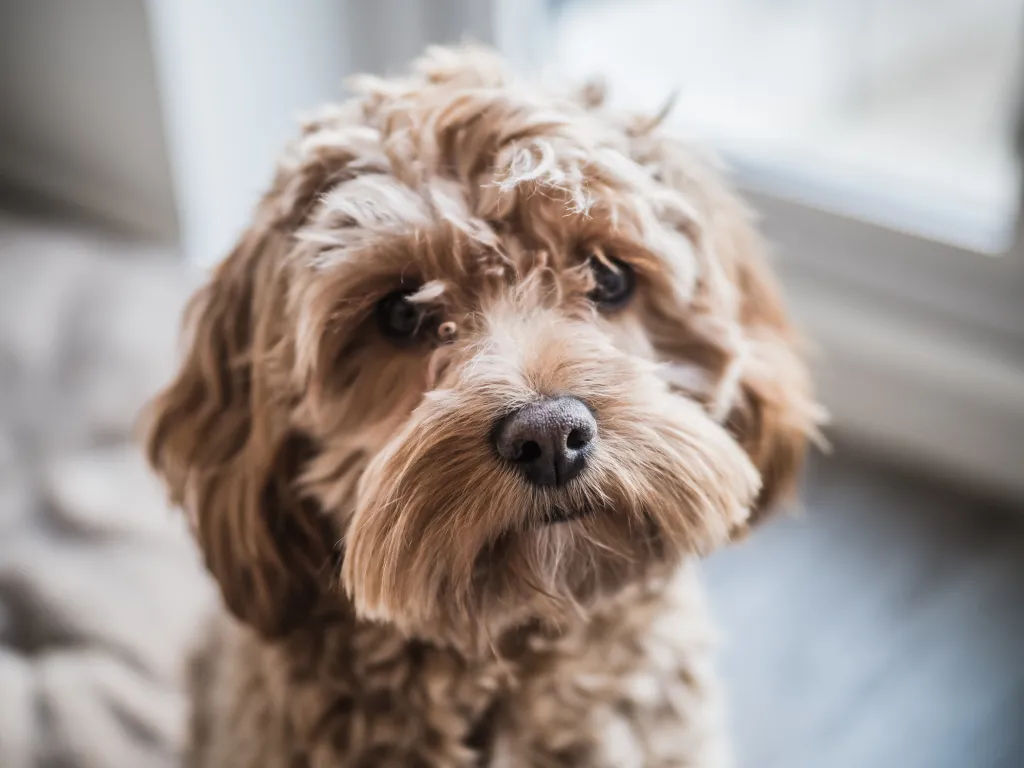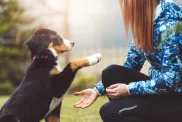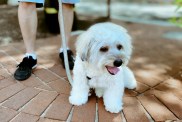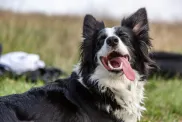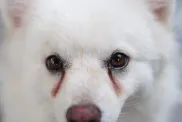An adorable, small dog with the personality of a big clown, the Cockapoo is perhaps the first of the “designer dogs” (not a purebred dog breed), dating back to the 1960s, rather than to just a few years ago.
Despite their unfortunate status as a designer breed, you can find these hybrid dogs in shelters and rescues, so opt to adopt if you’re able!
Breeders combined the Cocker Spaniel and Poodle breeds to make a completely people-oriented hybrid who’s intelligent enough to train easily, hardly sheds, forgives quickly, and is so affectionate that you’ll never feel alone. In fact, you might even have to shut the bathroom door for a minute of privacy.
Your hybrid buddy will also be happy running around an agility course, showing off their tricks to company, being petted as a therapy dog, or just hanging out on your lap. Your lap is theirs, by the way.
See below for a complete list of this hybrid dog breed’s characteristics!
Cockapoo Hybrid Dog Breed Pictures
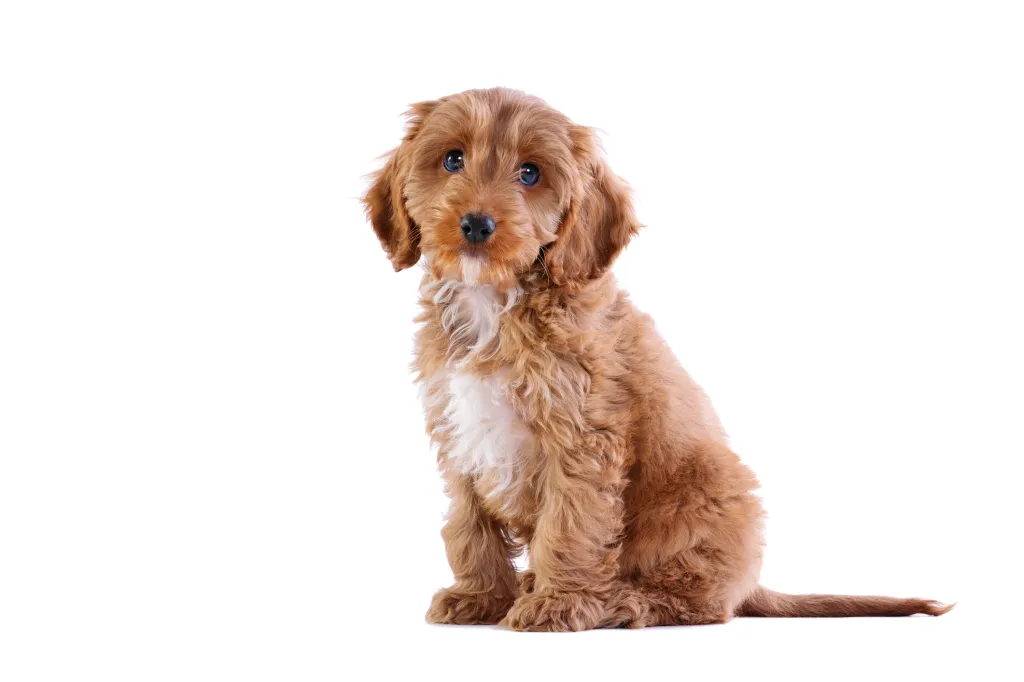
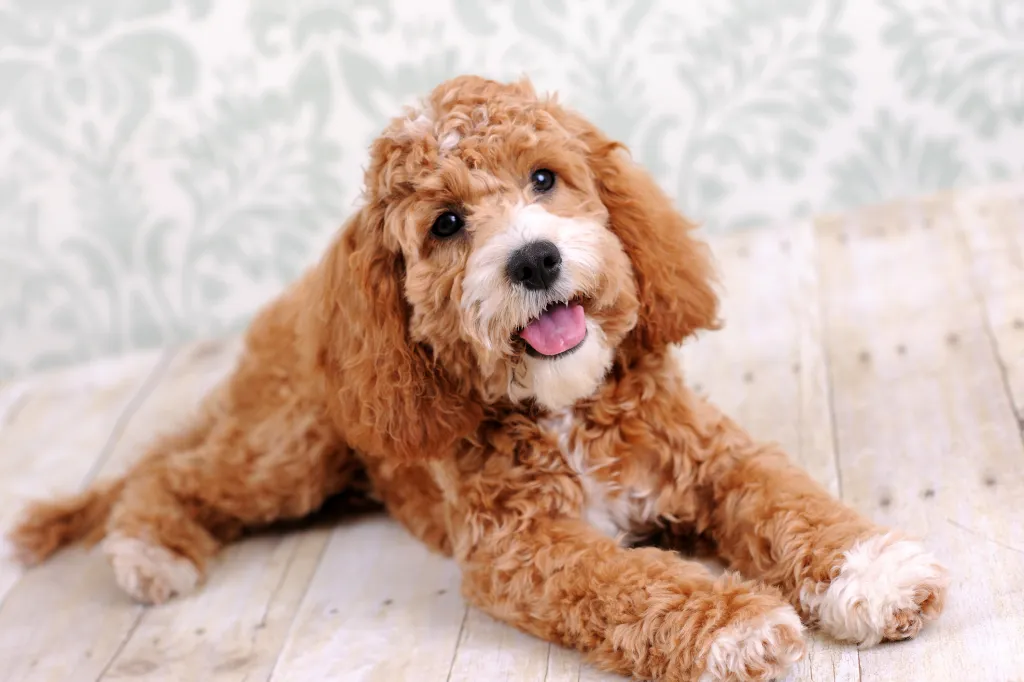
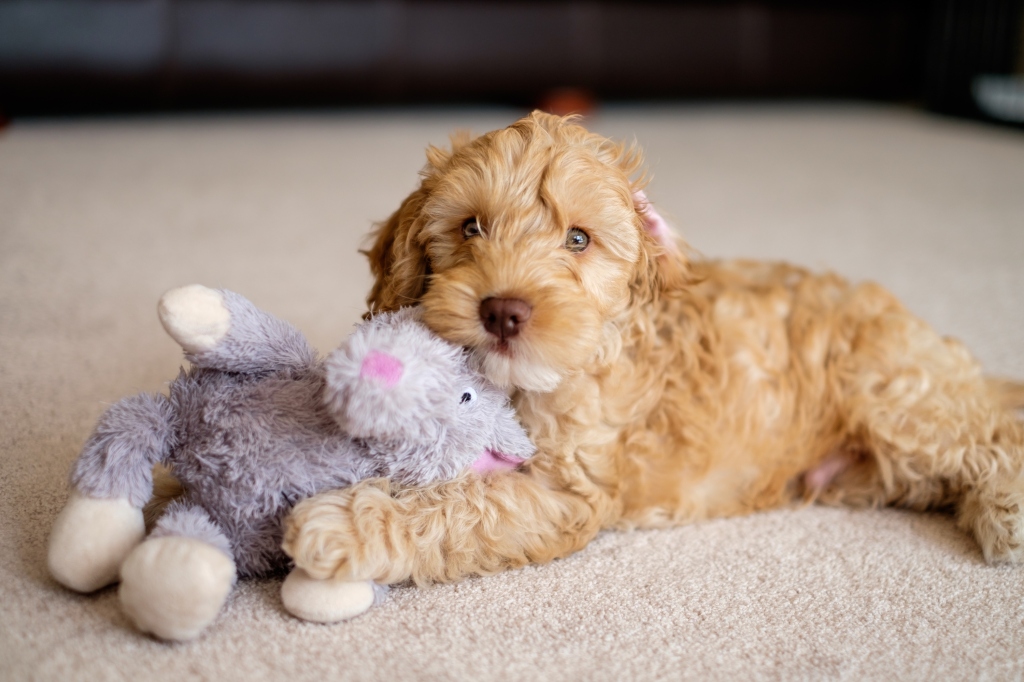
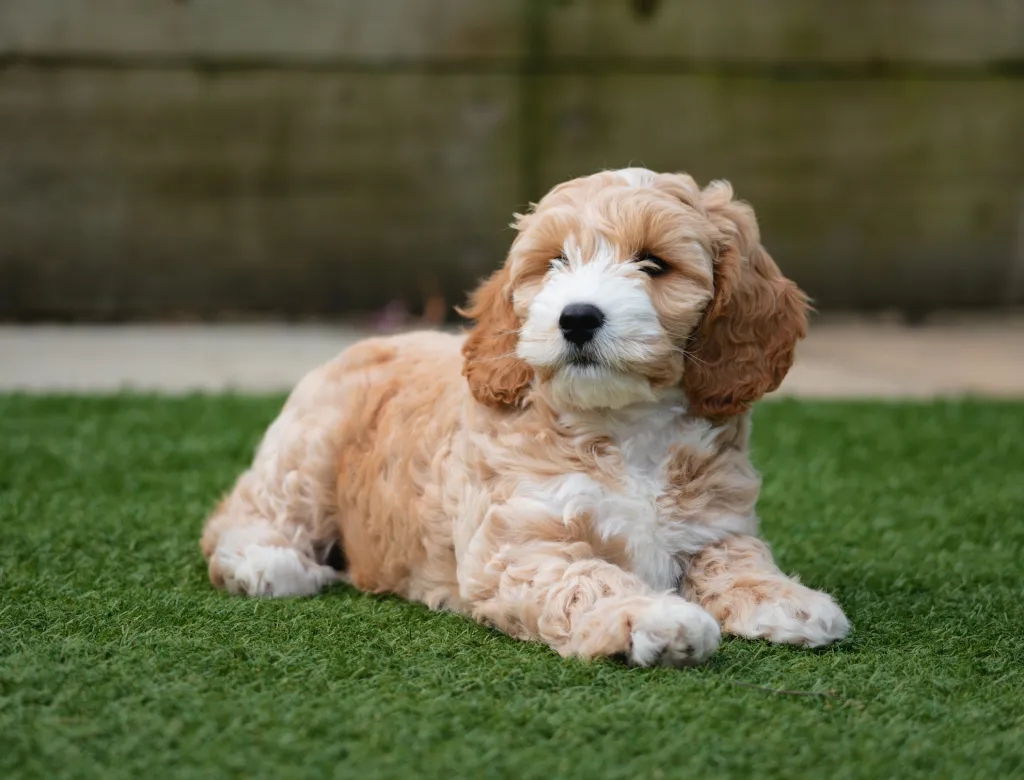
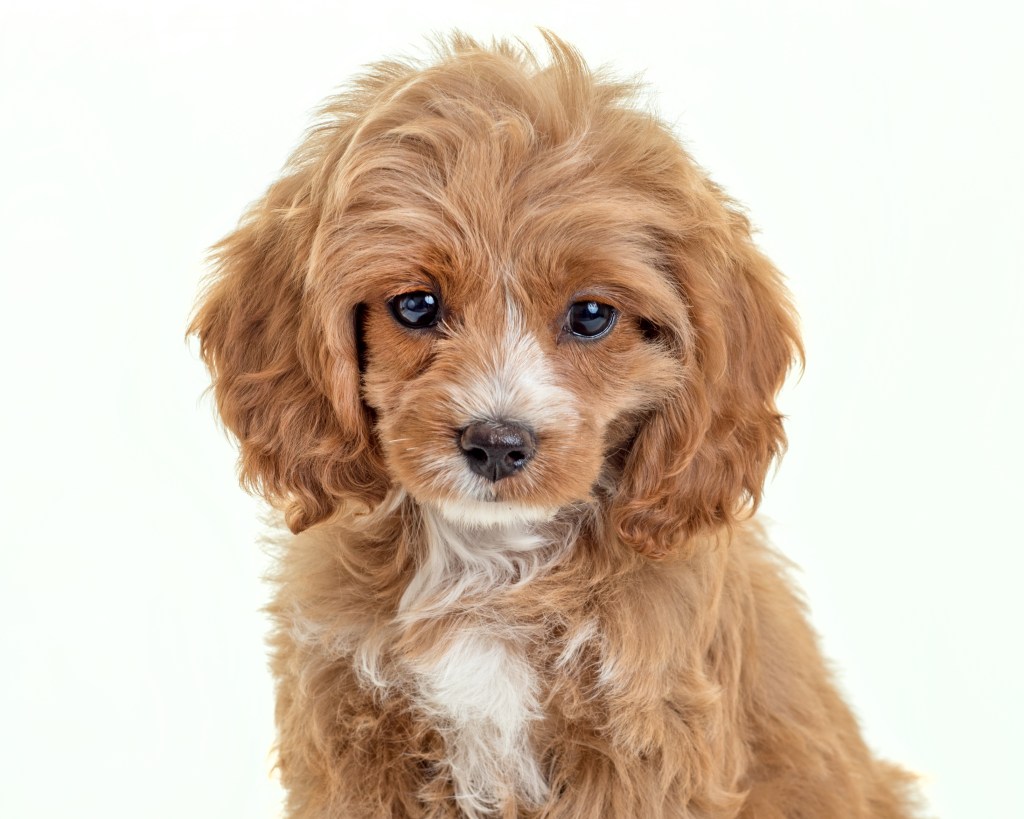
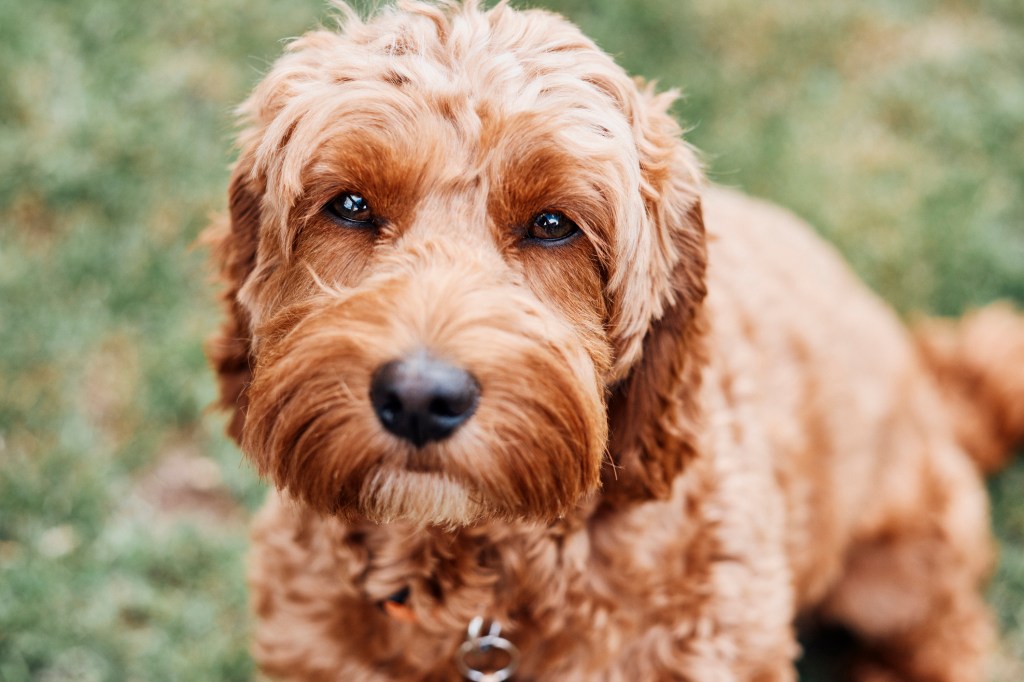
Adaptability
-
Adapts Well To Apartment Living
Looking for the best dog for your apartment? Contrary to popular belief, the suitability of dogs who adapt well to apartment living goes beyond its size. Apartment dwellers have a myriad of dog breeds to choose from as potential companions, with various factors to consider. Some large breeds can adapt well to apartment living and have lower activity levels. Others may require more space and possess higher energy levels. On the other hand, certain small dog breeds with abundant energy can still find contentment with indoor playtime or brisk walks.
However, when selecting a dog that adapts well apartments, it is essential to prioritize your neighbors. Opting for a pet that doesn’t excessively bark and behaves politely when encountering others in shared spaces like is crucial for maintaining a harmonious apartment environment.
In high-rise settings, it’s worth noting that numerous small dogs may exhibit a propensity for high energy and frequent barking. This makes them less suitable for apartment living. Therefore, desirable qualities in an apartment dog encompass being quiet, low-energy, and displaying polite behavior towards other residents.
Factors To Consider When Choosing A Dog For An Apartment
When considering dogs that adapt well to apartments, size alone should not be the sole determinant. Apartment dwellers have a wealth of dog breeds to choose from as potential furry companions. It’s important to remember that the size of your living space is just one factor to consider. While some larger breeds can adapt well to apartment living, with lower, others may require more space and have higher energy levels, making them less suitable for smaller apartments. Conversely, certain small dog breeds with higher energy levels can still thrive in apartments, finding contentment through indoor playtime or brisk walks. However, it is crucial to consider your neighbors’ comfort when selecting a dog. Opt for a pet that doesn’t bark excessively and behaves politely when interacting with others in shared spaces.
Therefore, it’s important to prioritize qualities such as being quiet, low-energy, calm indoors, and exhibiting good manners when living in close proximity to other residents. By considering these factors, you can find a dog that will adapt well to apartment living and create a harmonious living environment for everyone involved.
-
Good For Novice Owners
Some dogs are simply easier than others; they take to training better and are fairly easygoing. They’re also resilient enough to bounce back from your mistakes or inconsistencies.
Dogs who are highly sensitive, independent thinking, or assertive may be harder for a first-time dog parent to manage. You’ll get your best match if you take your dog-owning experience into account as you choose your new pooch.
If you’re new to dog parenting, take a look at 101 Dog Tricks and read up on how to train your dog!
-
Sensitivity Level
Some dogs will let a stern reprimand roll off their backs, while others take even a dirty look to heart. Low-sensitivity dogs, also called “easygoing,” “tolerant,” “resilient,” and even “thick-skinned,” can better handle a noisy, chaotic household, a louder or more assertive owner, and an inconsistent or variable routine. Do you have young kids, throw lots of dinner parties, play in a garage band, or lead a hectic life? Go with a low-sensitivity dog.
-
Tolerates Being Alone
Some breeds bond very closely with their family and are more prone to worry or even panic when left alone by their owner. An anxious dog can be very destructive–barking, whining, chewing, and otherwise causing mayhem. These breeds do best when a family member is home during the day or if you can take the dog to work.
-
Tolerates Cold Weather
Breeds with very short coats and little or no undercoat or body fat, such as Greyhounds, are vulnerable to the cold. Dogs with a low cold tolerance need to live inside in cool climates and should have a jacket or sweater for chilly walks. You can find a great jacket for your dog here!
-
Tolerates Hot Weather
Dogs with thick, double coats are more vulnerable to overheating. So are breeds with short noses, like Bulldogs or Pugs, since they can’t pant as well to cool themselves off. If you want a heat-sensitive breed, your dog will need to stay indoors with you on warm or humid days, and you’ll need to be extra cautious about exercising your dog in the heat.
All-around friendliness
-
Affectionate With Family
When it comes to unconditional love and unwavering loyalty, few animals can rival the affectionate nature of dogs. These remarkable creatures have earned their reputation as man’s best friend, and many breeds are particularly renowned for their love and devotion to their families. With their warm hearts and wagging tails, affectionate family dogs enrich the lives of their owners in countless ways.
One such breed known for its affectionate demeanor is the Golden Retriever. With their gentle temperament and friendly disposition, Golden Retrievers form deep bonds with their families. They eagerly participate in family activities, whether it’s a game of fetch in the yard or cuddling on the couch during a movie night. Their expressive eyes and ever-wagging tails are a testament to the joy they feel in the presence of their loved ones.
Another family-favorite breed is the Labrador Retriever. Renowned for their playful and patient nature, Labradors are excellent companions for children and adults alike. They readily engage in playtime with the kids, showcasing their boundless energy and enthusiasm. But when the day winds down, they seamlessly transition into loving and gentle cuddle buddies, comforting their family members with their warm presence.
Beyond specific breeds, mixed-breed dogs also have a special place in the hearts of families seeking affectionate companions. The shelter dogs, in particular, form deep connections with their adoptive families. They seem to understand the second chance they’ve been given and repay it with endless love and gratitude.
How To Know If A Dog Is Good With Families
The affectionate nature of family dogs extends beyond play and cuddles. Dogs have a remarkable ability to sense their owner’s emotions, offering comfort and support during difficult times. Whether it’s a wagging tail after a long day at work or a sympathetic nuzzle during moments of sadness, they prove time and again that they are attuned to their family’s needs.
It is important to note that not all dogs of the same breed will be equally affectionate. Some dogs may be more independent or aloof, while others may be more clingy or demanding of attention. The best way to find out how affectionate a dog is is to meet them in person and interact with them.
-
Kid-Friendly
Being gentle with children, sturdy enough to handle the heavy-handed pets and hugs they can dish out, and having a blasé attitude toward running, screaming children are all traits that make a kid-friendly dog. You may be surprised by who’s on that list: Fierce-looking Boxers are considered good with children, as are American Staffordshire Terriers (which are considered Pit Bulls). Small, delicate, and potentially snappy dogs such as Chihuahuas aren’t always so family-friendly.
**All dogs are individuals. Our ratings are generalizations, and they’re not a guarantee of how any breed or individual dog will behave. Dogs from any breed can be good with children based on their past experiences, training on how to get along with kids, and personality. No matter what the breed or breed type, all dogs have strong jaws, sharp pointy teeth, and may bite in stressful circumstances. Young children and dogs of any breed should always be supervised by an adult and never left alone together, period.
-
Dog Friendly
Friendliness toward dogs and friendliness toward humans are two completely different things. Some dogs may attack or try to dominate other dogs, even if they’re love-bugs with people; others would rather play than fight; and some will turn tail and run. Breed isn’t the only factor. Dogs who lived with their littermates and mother until at least six to eight weeks of age and who spent lots of time playing with other dogs during puppyhood, are more likely to have good canine social skills.
-
Friendly Toward Strangers
Stranger-friendly dogs will greet guests with wagging tails and nuzzles; others are shy, indifferent, or even aggressive. However, no matter what the breed, a dog who was socialized and exposed to lots of different types, ages, sizes, and shapes of people as a puppy will respond better to strangers as an adult. Remember that even friendly dogs should stay on a good, strong leash like this one in public!
Health And Grooming Needs
-
Amount Of Shedding
If you’re going to share your home with a dog, you’ll need to deal with some level of dog hair on your clothes and in your house. However, shedding does vary greatly among the breeds. Some dogs shed year-round, some “blow” seasonally, some do both, and some shed hardly at all. If you’re a neatnik, you’ll need to either pick a low-shedding breed or relax your standards. To help keep your home a little cleaner, you can find a great de-shedding tool here!
-
Drooling Potential
Drool-prone dogs may drape ropes of slobber on your arm and leave big, wet spots on your clothes when they come over to say hello. If you’ve got a laid-back attitude toward slobber, fine; but if you’re a neatnik, you may want to choose a dog who rates low in the drool department.
-
Easy To Groom
Some breeds are brush-and-go dogs; others require regular bathing, clipping, and other grooming just to stay clean and healthy. Consider whether you have the time and patience for a dog who needs a lot of grooming, or the money to pay someone else to do it.
-
General Health
Due to poor breeding practices, some breeds are prone to certain genetic health problems, such as hip dysplasia. This doesn’t mean that every dog of that breed will develop those diseases; it just means that they’re at an increased risk.
If you’re adopting a puppy, it’s a good idea to find out which genetic illnesses are common to the breed you’re interested in. You may also want to ask if your shelter or rescue has information about the physical health of your potential pup’s parents and other relatives.
-
Potential For Weight Gain
Some breeds have hearty appetites and tend to put on weight easily. As in humans, being overweight can cause health problems in dogs. If you pick a breed that’s prone to packing on pounds, you’ll need to limit treats, make sure they get enough exercise, and measure out their daily food servings into regular meals rather than leaving food out all the time.
Ask your vet about your dog’s diet and what they recommend for feeding your pooch to keep them at a healthy weight. Weight gain can lead to other health issues or worsen problems like arthritis.
-
Size
Get ready to meet the giants of the doggy world! Large dog breeds aren’t just big balls of fluff, they’re like loving, oversized teddy bears on a mission to steal your heart. Need some convincing? Let’s dive into the awesome benefits of owning one!
First things first, these pooches are a living security system! With their impressive size and thunderous barks, they’ll have any would-be intruder running for the hills. Talk about peace of mind! Plus, who needs an alarm when you’ve got a furry giant protecting your castle?
But that’s not all. Large dog breeds are all about loyalty and devotion. They’ll stick by your side through thick and thin, becoming your most dedicated bestie. Their love knows no bounds! When you have a giant fluffball showing you unconditional love, you’ll feel like the luckiest human on the planet.
Now, let’s talk about their talents. These big fellas are the ultimate working partners. With brains and brawn, they’re up for any challenge. From search and rescue missions to lending a helping paw to those in need, these dogs are superheroes in fur coats. They’ll make you proud every step of the way!
Don’t let their size fool you—these gentle giants have hearts as big as their paws. They’re incredible with kids and other pets, spreading their love like confetti. Their patience and kindness make them perfect family pets, ensuring harmony in your household.
Oh, and get ready to break a sweat! These dogs are fitness enthusiasts, and they’ll keep you on your toes. Daily walks, jogs, and play sessions will not only keep them happy and healthy but will also give you a reason to ditch the couch and join in on the fun. It’s a win-win situation!
So, if you’re ready for a dose of big love, go ahead and consider a large dog breed. They’re the best wing-dog you could ever ask for, ready to make your life a thousand times more exciting, loving, and downright awesome! Get ready for the big adventure of a lifetime!
Trainability
-
Easy To Train
Easy-to-train dogs are more adept at forming an association between a prompt (such as the word “sit”), an action (sitting), and a consequence (getting a treat) very quickly. Other dogs need more time, patience, and repetition during training.
Many breeds are intelligent but approach training with a “What’s in it for me?” attitude, in which case you’ll need to use rewards and games to teach them to want to comply with your requests.
Related:
10 Fun, Impressive Tricks You Can Teach Any Dog
-
Intelligence
Dogs who were bred for jobs that require decision making, intelligence, and concentration, such as herding livestock, need to exercise their brains, just as dogs who were bred to run all day need to exercise their bodies. If they don’t get the mental stimulation they need, they’ll make their own work–usually with projects you won’t like, such as digging and chewing. Obedience training and interactive dog toys are good ways to give a dog a brain workout, as are dog sports and careers, such as agility and search and rescue.
-
Potential For Mouthiness
Common in most breeds during puppyhood and in Retriever breeds at all ages, mouthiness means a tendency to nip, chew, and play-bite (a soft, fairly painless bite that doesn’t puncture the skin). Mouthy dogs are more likely to use their mouths to hold or “herd” their human family members, and they need training to learn that it’s fine to gnaw on chew toys, but not on people. Mouthy breeds tend to really enjoy a game of fetch, as well as a good chew on a toy that’s been stuffed with kibble and treats.
-
Prey Drive
Dogs with a high prey drive have an instinctive desire to stalk, capture, and prey upon potential food sources. Dogs who were bred to hunt, such as Terriers, have an inborn desire to chase — and sometimes kill — other animals. Anything whizzing by — such as cats, squirrels, and perhaps even cars — can trigger that instinct.
How to address a high prey drive
Off-leash adventures are too great a temptation for pups who will wander and hunt. Dogs who like to chase need to be leashed. And, even on a leash, you may experience your dog pulling on the leash to reach rodents or birds in their sight. Otherwise, these pups should be kept in a fenced area when outdoors. If your pup has a high prey drive, you’ll need a high, secure fence in your yard.
These breeds generally aren’t a good fit for homes with smaller pets that can look like prey, such as cats, hamsters, or small dogs. Breeds that were originally used for bird hunting, on the other hand, generally won’t chase, but you’ll probably have a hard time getting their attention when there are birds flying by.
Other behavioral concerns
Observing your dog’s prey drive, which is instinctual and biologically-rooted, is not the same as observing aggression. Much aggression is born of fear and anxiety, especially in the case of dog aggression toward humans.
The tendency to wander, even into oncoming traffic, can produce diasterious results for pups with predatory instincts. It can also lead to pups being bitten by snakes or attacked by other wild animals they may pursue while on the hunt.
-
Tendency To Bark Or Howl
Some breeds sound off more often than others. When choosing a breed, think about how often the dog vocalizes. Learn more about breeds with a tendency to bark or howl.
If you’re considering a hound, would you find their trademark howls musical or maddening? If you’re considering a watchdog, will a city full of suspicious “strangers” put your pup on permanent alert? Will the local wildlife literally drive your dog wild? Do you live in housing with noise restrictions? Do you have neighbors nearby? Then you may wish to choose a quieter dog.
-
Wanderlust Potential
Some breeds are more free-spirited than others. Nordic dogs such as Siberian Huskies were bred to range long distances, and given the chance, they’ll take off after anything that catches their interest. And many hounds simply must follow their noses–or that bunny that just ran across the path–even if it means leaving you behind.
Exercise needs
-
Energy Level
High-energy dogs are always ready and waiting for action. Originally bred to perform a canine job of some sort, such as retrieving game for hunters or herding livestock, they have the stamina to put in a full workday. They need a significant amount of exercise and mental stimulation, and they’re more likely to spend time jumping, playing, and investigating any new sights and smells.
Low-energy dogs are the canine equivalent of a couch potato, content to doze the day away. When picking a breed, consider your own activity level and lifestyle, and think about whether you’ll find a frisky, energetic dog invigorating or annoying.
-
Intensity
A vigorous dog may or may not have high energy, but everything they do, they do with vigor: they strain on the leash (until you train them not to), try to plow through obstacles, and even eats and drinks with great big gulps. These dynamos need lots of training to learn good manners, and may not be the best fit for a home with young kids or someone who’s elderly or frail. A low-vigor dog, on the other hand, has a more subdued approach to life.
-
Exercise Needs
Some breeds do fine with a slow evening stroll around the block. Others need daily, vigorous exercise, especially those that were originally bred for physically demanding jobs, like herding or hunting.
Without enough exercise, these breeds may put on weight and vent their pent-up energy in ways you don’t like, such as barking, chewing, and digging. Breeds that need a lot of exercise are good for outdoorsy, active people, or those interested in training their dog to compete in a high-energy dog sport, such as agility.
-
Potential For Playfulness
Some dogs are perpetual puppies — always begging for a game — while others are more serious and sedate. Although a playful pup sounds endearing, consider how many games of fetch or tag you want to play each day, and whether you have kids or other dogs who can stand in as playmates for the dog.
Cockapoo Overview
The Cockapoo blazed the trail among planned hybrids; he’s the offspring of the Poodle and the Cocker Spaniel. Also known as the Cockapoodle, Cockerpoo, or Cock-a-Poo, he’s an utterly adorable little dog with a face that could melt a heart of stone. He’s affectionate and accepts everyone — old folks, kids, and other pets. He’s also of an easy size, being small enough to cuddle and big enough to romp with bigger dogs. Cockapoos have an infectious zest for life that spreads to everyone around them, that essential joie de vivre that makes every day a celebration. These guys are just plain happy to be alive. Still, what’s the draw in getting a Cockapoo instead of a Cocker Spaniel or a Poodle? It’s that, in some ways, the Cockapoo represents two ideals: first, what the Cocker Spaniel used to be across the board — a sweet and stable temperament, before the breed’s popularity skyrocketed in the wake of Lady and the Tramp; and second, the Poodle’s orientation to people smooths out the Cockers’ orientation to their noses when they’re out in the field. Furthermore, Cockapoos don’t require the level of grooming that Poodles do, and people don’t automatically react as negatively as they do to a Poodle’s extravagant grooming style for showing in conformation. (While it’s not fair to dislike the intelligent and jovial Poodle because of a show cut, the Poodle’s mostly undeserved reputation of high maintenance is pervasive.) Of course, there’s a world of difference between an intentional breeding of carefully selected Cocker Spaniels and Poodles versus a Poodle mix who’s just called a Cockapoo because no one has any clue what his background really is. The true Cockapoo been bred with the goal of a healthy, hypoallergenic dog with a good temperament. Cockapoo breeders feel that the dog’s health and temperament are far more important than appearance, and that’s what they continue to strive for (but nevertheless, the Cockapoo tends to be an adorable-looking fellow). You won’t find many, if any, discussions among these breeders about head shape and height. When the cross works as intended, you get the intelligence and spirit of the Poodle with the sturdiness and field spirit of the Cocker. Of course, when the cross doesn’t work, you can get a submissive, urinating fear-biter — but that can happen in any mixed breed, and in any purebred with unhappy genes. Generally, the Cocker Spaniel used to create the Cockapoo is an American Cocker Spaniel, but some are the offspring of Poodles and English Cocker Spaniels; the latter is often called a Spoodle. Efforts have been made over the last decade to clearly separate Cockapoos and Spoodles into two different hybrids, and some success has been achieved. If the type of Cocker involved is important to you, be sure to ask. But all that is neither here nor there for the Cockapoo enthusiast, who just wants to hang out with a sweet, cute, attached dog who isn’t quite the barnacle a Toy Poodle can be, and who began as a sparkle in the eye of a Cocker Spaniel with a lovely, even temperament.
Cockapoo Highlights
- The Cockapoo is not known to be a barker. Some, however, will bark when they see someone approaching their house, or when they’re left alone for long periods at a time.
- The Cockapoo should be a nonshedding dog with little doggy odor to the skin and coat. He requires daily brushings and will need his hair trimmed and clipped occasionally.
- Cockapoos are usually good for people with allergies since they produce low amounts of dander and hair.
- Cockapoos were developed to be companion dogs and are usually friendly and extraordinarily happy. They can do well with other dogs, pets, and children; older, more considerate children are generally best, however.
- Although the Standard or Maxi Cockapoo doesn’t adapt as readily to apartment life as his smaller cohorts do, he can do well if exercised properly. The ideal situation is a house with a small, fenced yard.
- The Cockapoo is so intelligent that he’s easy to train with positive reinforcement.
- Cockapoos have a moderate energy level but still need daily exercise. Expect to give him at least 15 minutes per day and offer a variety of activities, such as games of fetch, walks, and good runs.
- To get a healthy dog, never buy a puppy from an irresponsible breeder, puppy mill, or pet store. There are many responsible Cockapoo breeders, and some are registered with either the Cockapoo Club of America or the North American Cockapoo Registry.
- Designer dogs, also called hybrids, aren’t true breeds — they’re crosses of two specific breeds. If you’re interested in a Cockapoo puppy, understand that his looks, size, and temperament aren’t as predictable as those of purebreds, since you don’t know which characteristics from each breed will show up in any given dog. Test
Cockapoo History
When it comes to designer dogs, the Cockapoo is an old hybrid, popular since the 1960s. The first breeding may have been accidental, but the happy result was a litter of puppies who were intelligent, almost odorless, had the low-shedding Poodle coat, and showed the easygoing and loving nature of the Cocker Spaniel. These puppies were well received, and the Cockapoo line began. Some efforts are being made today to establish breed standards and start the Cockapoo on the hard road of becoming a true breed, one producing offspring with consistent traits. They’re one of the few designer breeds who aren’t owner-surrendered at high rates, even now, and many fanciers of the breed attribute that desirable circumstance to the Cockapoo’s intelligence and his sweet and loving disposition. He’s become a highly prized family dog. Once the Cockapoo became more well-known, he only grew in popularity. Some Cockapoo breeders want to make the Cockapoo a purebred dog and use multigeneration crossing, while other breeders prefer the basic Poodle/Cocker cross. There are Cockapoo clubs, but they’re unaffiliated because of these differing philosophies. The Cockapoo Club of America formed in 1999 and, in an effort to create breeding consistency, it created a breed standard. The club promotes breeding multigenerational Cockapoos to each other as opposed to creating new first generations, because this technique is supposed to help puppies maintain the desired qualities that aren’t seen in all first-generation dogs. The American Cockapoo Club was formed in 2004; these members don’t mix generations and don’t breed a Cockapoo back to a Poodle or a Cocker Spaniel. They too have a breed standard, and their goal is “to see genuine Cockapoos bred with lines that can be traced back to their originating roots of AKC/CKC Cocker Spaniels and AKC/CKC Poodles.” The North American Cockapoo Registry is also working to establish the Cockapoo as a viable breed. This group formed in 1999 and provides certification for Cockapoos who are the results of first- through sixth-generation breedings. The Registry stipulates that “a true Cockapoo is ONLY a purposeful, planned crossing of a purebred Cocker Spaniel with a purebred Poodle.” Breeding philosophies aside, the Cockapoo’s popularity hasn’t just held steady — it has increased over the decades. With the help of responsible breeders and national organizations and clubs, the Cockapoo, in one form or another, could be on his way to becoming much more than a “designer breed.”
Cockapoo Size
The Cockapoo is bred in four different size categories:
- The Teacup Toy is less than 6 pounds in weight and less than 10 inches in height.
- The Toy Cockapoo can reach 10 inches in height but has a sturdier build, the bigger ones tipping the scales at just under 12 pounds.
- The Miniature Cockapoo weighs 13 to 18 pounds and ranges between 11 and 14 inches high.
- The Standard or Maxi Cockapoo should weigh more than 19 pounds and be at least 15 inches in height.
Cockapoo Personality
Intelligent and easy to please, the Cockapoo was established as a companion dog. He’s friendly and happy, happy, happy. He has an outgoing nature and usually gets along with everyone. Depending on his temperament, he can be active or he can simply enjoy snuggling up on the couch with you.
He has the intelligence of his Poodle forebears but also the sweet disposition of his Cocker Spaniel ancestry. If the parents don’t have the loving quality that is expected in a Cockapoo, then their offspring won’t either.
Like every dog, the Cockapoo needs early socialization — exposure to many different people, sights, sounds, and experiences — when they’re young. Socialization helps ensure that your Cockapoo puppy grows up to be a well-rounded dog.
He prefers, always, to be with his family and can suffer from separation anxiety when left alone for too long. He can be easy to train, though that’s dependent on the parents’ temperament. Positive reinforcement is the best way to train a Cockapoo; he can achieve high levels of obedience with time and patience.
Cockapoo Health
The notion of hybrid vigor is worth understanding if you’re looking for a Cockapoo. Hybrid vigor isn’t necessarily characteristic of mixed breeds; it occurs when new blood is brought in from outside the usual breeding circle — it’s the opposite of inbreeding.
However, there is a general misconception that hybrid vigor automatically applies to mixed breeds. If the genetic pool for the mixed breed remains the same over time, the offspring won’t have hybrid vigor. And if a purebred breeder brings in a dog from an unrelated line, those puppies will have hybrid vigor, even though they’re purebred.
Not all Cockapoos will get any or all of these diseases, but
it’s important to be aware of them if you’re considering this breed.
- Cataracts: Cataracts cause opacity on the lens of the eye, resulting in poor vision. The dog’s eye(s) will have a cloudy appearance. Cataracts usually occur in old age and sometimes can be surgically removed to improve vision.
- Patellar Luxation: Also known as slipped stifles, this is a common problem in small dogs. The patella is the kneecap. Luxation means dislocation of an anatomical part (as a bone at a joint). Patellar luxation is when the knee joint (often of a hind leg) slides in and out of place, causing pain. This can be crippling, although many dogs lead relatively normal lives with this condition.
- Hip Dysplasia: This is an inherited condition in which the thighbone doesn’t fit snugly into the hip joint. Some dogs show pain and lameness on one or both rear legs, but others don’t display outward signs of discomfort. (X-ray screening is the most certain way to diagnose the problem.) Either way, arthritis can develop as the dog ages. Dogs with hip dysplasia should not be bred — so if you’re buying a puppy, ask the breeder for proof that the parents have been tested for hip dysplasia and are free of problems.
- Allergies: Allergies are a common ailment in dogs, and the Cockapoo is no exception. There are three main types of allergies: food allergies, which are treated by eliminating certain foods from the dog’s diet; contact allergies, which are caused by a reaction to a topical substance such as bedding, flea powders, dog shampoos, and other chemicals; and inhalant allergies, which are caused by airborne allergens such as pollen, dust, and mildew. Treatment varies according to the cause and may include dietary restrictions, medications, and environmental changes.
- Liver Disease: This condition is becoming more prevalent in Cocker Spaniels in two forms: chronic active hepatitis and copper toxicosis (poisoning). Both conditions may or may not be genetic; at this point no one is certain. More research is needed, but meanwhile ask your Cockapoo breeder about the parent Cocker’s liver history.
- Ear Infections: These afflictions may plague the Cockapoo because of his floppy Cocker ears, which can trap moisture, dirt, and debris. The Cockapoo’s ears should be regularly checked and cleaned. Ask your veterinarian about appropriate ear care products.
If you’re buying a puppy, find a good breeder who will show you health clearances for both your puppy’s parents. Health clearances prove that a dog has been tested for and cleared of a particular condition.
In Cockapoos, you should expect to see health clearances from the Orthopedic Foundation for Animals (OFA) for hip dysplasia (with a score of fair or better), elbow dysplasia, hypothyroidism, and von Willebrand’s disease; from Auburn University for thrombopathia; and from the Canine Eye Registry Foundation (CERF) certifying that eyes are normal. You can confirm health clearances by checking the OFA web site (offa.org).
Health clearances are not issued to dogs younger than 2 years of age. That’s because some health problems don’t appear until a dog reaches full maturity. For this reason, it’s often recommended that dogs not be bred until they are two or three years old.
Cockapoo Care
Most Cockapoos have a moderate level of energy, but that doesn’t mean they’ll laze around all day. They enjoy a good walk — and need it to keep them from becoming overweight. The best type of exercise, though, is a good play session in the backyard. Expect him to need at least 15 minutes of exercise every day.
The Cockapoo is an adaptable breed. He can live in an apartment, though the smaller varieties seem to do better there than do the Maxi or Standard Cockapoos. None of them should live outdoors or in kennels, since they’ve been bred to be companion dogs. They thrive when with their family and can suffer from separation anxiety when left for long periods of time — and that can lead to excessive barking and to destructive behavior.
Crate training benefits every dog and is a kind way to ensure that your Cockapoo doesn’t have accidents in the house or get into things he shouldn’t. A crate is also a place where he can retreat for a nap. Crate training at a young age will also help your Cockapoo accept confinement if he ever needs to be boarded or hospitalized.
Don’t stick your Cockapoo in a crate all day long, however. It’s not a jail, and he shouldn’t spend more than a few hours at a time in it except when he’s sleeping at night (although he would much prefer your bed). Cockapoos are people dogs, and they aren’t meant to spend their lives locked up in a crate or kennel.
Cockapoo Feeding
Recommended daily amount: 1/4 to 3/4 cup of high-quality dry food a day, divided into two meals.
NOTE: How much your adult dog eats depends on his size, age, build, metabolism, and activity level. Dogs are individuals, just like people, and they don’t all need the same amount of food. It almost goes without saying that a highly active dog will need more than a couch potato dog. The quality of dog food you buy also makes a difference — the better the dog food, the further it will go toward nourishing your dog and the less of it you’ll need to shake into your dog’s bowl.
Keep your Cockapoo in good shape by measuring his food and feeding him twice a day rather than leaving food out all the time. If you’re unsure whether he’s overweight, give him the eye test and the hands-on test.
First, look down at him. You should be able to see a waist. Then place your hands on his back, thumbs along the spine, with the fingers spread downward. You should be able to feel but not see his ribs without having to press hard. If you can’t, he needs less food and more exercise.
For more on feeding your Cockapoo, see our guidelines for buying the right food, feeding your puppy, and feeding your adult dog.
Cockapoo Coat Color And Grooming
The Cockapoo has a single, long coat that can range from straight to loose curls, but it shouldn’t be kinky. Cockapoos can be found in all the colors and color combinations that are seen in both Cocker Spaniels and Poodles — a more rich variety of coat colors than is usual in many other breeds.
The Cockapoo is usually seen au naturel, but many people like to clip the coat. However, it should only be trimmed to two to three inches in length. Hair around the eyes should be trimmed to allow visibility, so he’s not doing an impression of an Old English Sheepdog. The coat should be brushed daily.
Although it’s different for every Cockapoo, a puppy resulting from a multigenerational breeding is supposed to be odorless and nonshedding (although “nonshedding” is a fantasy, since every dog on the planet sheds at least a tiny bit). To retain coat oils and health, he only need be bathed when absolutely necessary.
Because his floppy Cocker ears block air circulation, the ears must be checked and cleaned weekly to prevent ear infections. Gently wipe out the ear — only the part you can see! — with a cotton ball moistened with a cleaning solution recommended by your veterinarian. (Don’t stick cotton swabs or anything else into the ear canal, because that could damage it.) Your Cockapoo may have an ear infection if the inside of the ear smells bad, looks red or seems tender, or he frequently shakes his head or scratches at his ear.
Brush your Cockapoo’s teeth at least two or three times a week to remove tartar buildup and the bacteria that lurk inside it. Daily brushing is even better if you want to prevent gum disease and bad breath.
Trim nails once or twice a month if your dog doesn’t wear them down naturally to prevent painful tears and other problems. If you can hear them clicking on the floor, they’re too long. Dog toenails have blood vessels in them, and if you cut too far you can cause bleeding — and your dog may not cooperate the next time he sees the nail clippers come out. So, if you’re not experienced trimming dog nails, ask a vet or groomer for pointers.
Begin accustoming your Cockapoo to being brushed and examined when he’s a puppy. Handle his paws frequently — dogs are touchy about their feet — and look inside his mouth. Make grooming a positive experience filled with praise and rewards, and you’ll lay the groundwork for easy veterinary exams and other handling when he’s an adult.
As you groom, check for sores, rashes, or signs of infection such as redness, tenderness, or inflammation on the skin, in the nose, mouth, and eyes, and on the feet. Eyes should be clear, with no redness or discharge. Your careful weekly exam will help you spot potential health problems early.
Cockapoo Children And Other Pets
The Cockapoo does well with youngsters, although he generally prefers homes with older, more considerate children. He also gets along with other dogs and pets.
As with every breed, you should always teach children how to approach and touch dogs, and always supervise any interactions between dogs and young children to prevent any biting or ear or tail pulling on the part of either party.
Teach your child never to approach any dog while he’s eating or sleeping or to try to take the dog’s food away. No dog, no matter how friendly, should ever be left unsupervised with a child.
Cockapoo Rescue Groups
Cockapoos are often acquired without any clear understanding of what goes into owning one, and these dogs often end up in the care of rescue groups, in need of adoption or fostering. If you’re interested in adopting an Cockapoo, a rescue group is a good place to start.
DogTime participates in the NomNomNow affiliate program to earn fees for linking to products on NomNomNow.
